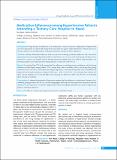Please use this identifier to cite or link to this item:
https://hdl.handle.net/20.500.14356/1358Full metadata record
| DC Field | Value | Language |
|---|---|---|
| dc.contributor.author | Roka, Tara | - |
| dc.contributor.author | Ghimire, Melina | - |
| dc.date.accessioned | 2023-05-08T10:21:31Z | - |
| dc.date.available | 2023-05-08T10:21:31Z | - |
| dc.date.issued | 2019 | - |
| dc.identifier.citation | RokaT., & GhimireM. (2020). Medication Adherence among Hypertensive Patients Attending a Tertiary Care Hospital in Nepal. Journal of Nepal Health Research Council, 17(4), 521-527. https://doi.org/10.33314/jnhrc.v17i4.2337 | en_US |
| dc.identifier.issn | Print ISSN: 1727-5482; Online ISSN: 1999-6217 | - |
| dc.identifier.uri | http://103.69.126.140:8080/handle/20.500.14356/1358 | - |
| dc.description | Original Article | en_US |
| dc.description.abstract | Abstract Background: Drug therapy and adherence to the medication is critical to prevent complications of hypertension and more importantly in countries like Nepal where more than one quarter adults suffer from it. Primary aim was to measure adherence to anti-hypertensive medication and factors associated with low adherence. Methods: Morisky Medication Adherence Scale was used for measuring medication adherence and a structured questionnaire for measuring background and illness related factors in a cross-sectional study among 216 hypertensive patients in a tertiary care hospital selected through sequential sampling. Data was analysed using descriptive and inferential statistics and results presented with proportion or odds ratio with 95% CI. Results: It was found that 72% of the patients had low adherence to anti-hypertensive medication, with sub-group differences notably higher among females (77%); among those with co-morbidity (80%); and among those getting medicines free of cost (76%). Post multivariate logistic regression, it was found that patients with co-morbidity had higher odds of having low adherence (Adjusted Odds Ratio – AOR: 2.50; 95%CI:1.28-4.89) than those without; and those who get medicine free of cost had higher odds of having low adherence (AOR: 3.01; 95%CI:1.32-6.86) than those who pay for medicine. Conclusions: A substantial proportion of hypertensive patients had low adherence to medication. Presence of co-morbidity, getting medicine free of cost, and not having regular follow up were the major factors associated with low adherence to anti-hypertensive medication. Targeted interventions in hospitals and health care centers in Nepal would improve medication adherence. Keywords: Adherence; hypertension; hypertensive patients; medication; Nepal. | en_US |
| dc.language.iso | en | en_US |
| dc.publisher | Nepal Health Research Council | en_US |
| dc.relation.ispartofseries | Oct-Dec, 2019;2337 | - |
| dc.subject | Adherence | en_US |
| dc.subject | Hypertension | en_US |
| dc.subject | Hypertensive patients | en_US |
| dc.subject | Medication | en_US |
| dc.subject | Nepal | en_US |
| dc.title | Medication Adherence among Hypertensive Patients Attending a Tertiary Care Hospital in Nepal | en_US |
| dc.type | Journal Article | en_US |
| local.journal.category | Original Article | - |
| Appears in Collections: | Vol. 17 No. 4 Issue 45 Oct-Dec 2019 | |
Files in This Item:
| File | Description | Size | Format | |
|---|---|---|---|---|
| 2337-Manuscript-13240-2-10-20200130.pdf | Fulltext Download | 996.49 kB | Adobe PDF |  View/Open |
Items in DSpace are protected by copyright, with all rights reserved, unless otherwise indicated.
